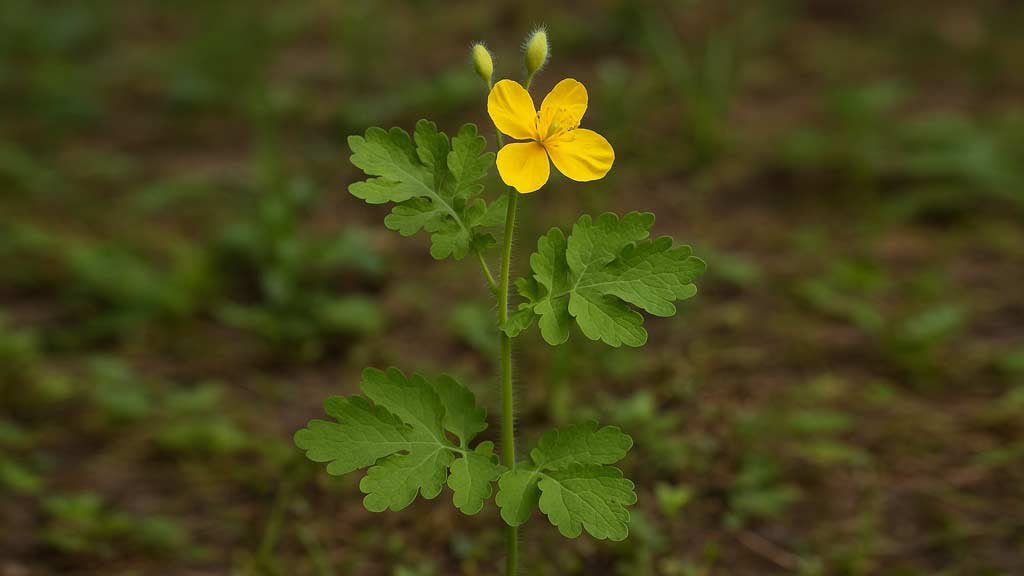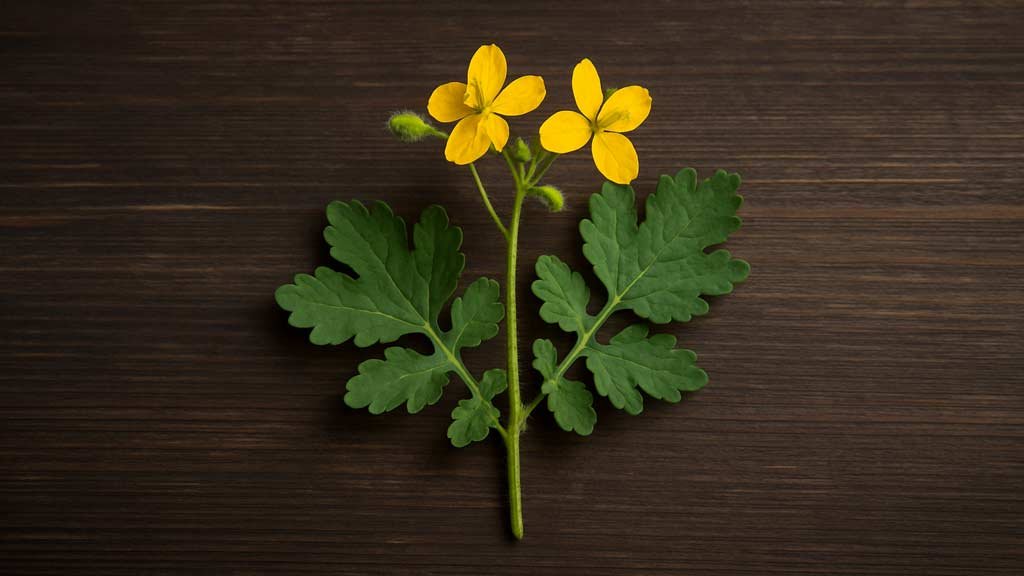A Herb That Refuses to Be Forgotten
Greater Celandine (Chelidonium majus) is one of those plants that sticks in memory once you meet it. Bright yellow flowers that seem to glow against rough green leaves, and if you snap the stem, an orange latex oozes out—thick, bitter, and unmistakably medicinal. For centuries, people have called on it for liver complaints, sluggish digestion, and gallbladder discomfort. Some herbalists swear by it; others tread carefully because it is powerful, even bordering on toxic in careless hands. But it has earned a place in the long story of herbal medicine, and it keeps coming back into the conversation whenever we talk about the liver and gallbladder.
Table of Contents
The Old World Reputation
Traditional healers across Europe leaned on Greater Celandine for generations. It was a standard plant in the pharmacopeia of medieval herbalists, often written about alongside milk thistle or dandelion when liver problems came up. Folk practitioners used the plant to stimulate bile flow, ease jaundice, or address what they called “congested livers.” Gallstones, too, were part of its reputation.
There’s even a linguistic hint at its reputation: the Latin name Chelidonium comes from “chelidōn,” meaning swallow, because the herb was said to bloom when swallows arrived and wither when they left. Old herbals repeated the story that swallows used the latex to help their chicks open their eyes. Whether true or not, it shows how deeply this plant was tied to cycles of cleansing, renewal, and vitality.
Modern Curiosity Meets Ancient Knowledge
When modern researchers began analyzing Greater Celandine, they found alkaloids—chelidonine, sanguinarine, berberine—compounds known to be physiologically active, some strongly so. These are not gentle chamomile molecules; they act on the liver, gallbladder, and digestive tract in ways that are noticeable. In small, well-prepared doses, the plant seems to stimulate bile production and flow. That might explain its use for indigestion, fat metabolism issues, or gallbladder stagnation.
But here’s the catch: in larger or uncontrolled amounts, these same alkaloids can irritate or even damage the liver. This paradox has fueled debate in herbal circles. Is Greater Celandine a healer of the liver, or a risk to it? The answer is not simple—it depends on dose, preparation, and context. Herbalists trained in European traditions often still use it, but carefully, respecting its strength.
A Plant for the Gallbladder
Gallbladder complaints are notoriously uncomfortable. Pain in the right upper abdomen, nausea after fatty meals, a sense of heaviness or cramping—these are the classic signs. Greater Celandine has been a traditional aid here, often combined with other cholagogues (bile movers) like artichoke leaf or boldo.
Herbalists suggest that the plant encourages the gallbladder to contract and release bile. This flow not only helps digest fats but also reduces the risk of bile stagnation and crystal formation, the precursors to gallstones. In folk practice, a tea or tincture of Greater Celandine was given to someone with sluggish digestion or early gallstone discomfort. Patients reported feeling lighter, less bloated, and more comfortable after meals.
Of course, no one in the old days talked about bile acids, cholesterol balance, or gallstone composition—they just knew when something “stuck” inside felt less stuck afterward.
The Liver Connection
Greater Celandine’s link to the liver runs deep. Traditional uses included:
- Supporting jaundice recovery
- Relieving a “blocked” or “congested” liver
- Easing pain under the right ribcage
- Helping skin eruptions believed to come from poor liver function
Today, herbalists might frame these as symptoms of poor bile flow, sluggish detoxification, or mild inflammation in the liver. Some even use the herb for what we’d now call non-alcoholic fatty liver, though with extreme caution and usually alongside other gentler herbs.
What makes it particularly interesting is how it straddles the line between stimulant and relaxant. Chelidonine, one of its alkaloids, seems to calm smooth muscles, potentially easing spasms in the bile ducts. Meanwhile, other alkaloids stimulate secretion. It’s a curious dance—push and relax, flow and ease.
Preparation and Traditional Use
You don’t just pluck Greater Celandine leaves and toss them in a salad. The plant is pungent, bitter, and full of latex. Traditional methods involved:
- Tincture: Alcohol extracts the alkaloids efficiently. Doses were small, often just a few drops diluted in water.
- Tea: Less common, since the latex makes it unpalatable, but used in mild preparations with other herbs.
- External applications: The orange latex was applied directly to warts, corns, or skin lesions. Folk healers prized it as a “wart killer.”
Dosage was everything. A skilled practitioner might prescribe just enough to nudge the liver into action without crossing into irritation.
Safety and Caution
This is not an herb to casually self-dose. Reports exist of liver toxicity linked to poorly controlled use of Greater Celandine. Herbalists who use it emphasize:
- Avoiding long-term use
- Sticking to low, carefully measured doses
- Never combining with alcohol abuse or existing severe liver disease
- Watching closely for side effects like nausea, abdominal pain, or jaundice
That said, many cases of toxicity involved misuse, excessive dosing, or unsupervised long-term use. Within the traditions that treat it with respect, problems were far less common. But the caution remains—it’s not a “kitchen herb.”

Greater Celandine in Context
One plant never tells the whole story. Herbalists rarely rely on Greater Celandine alone. It often sits in formulas with gentler partners that balance and soften its effect. For liver and gallbladder support, a blend might include:
- Milk Thistle for protection and regeneration
- Dandelion Root for gentle stimulation and diuretic action
- Artichoke Leaf for bile flow and cholesterol balance
- Peppermint for digestive comfort
In this context, Greater Celandine plays the role of the sharp tool—the one that cuts through stubborn congestion when milder herbs aren’t enough.
Anecdotes from Practice
I’ve heard stories from old herbalists who swore by a few drops of tincture after a heavy meal. One woman told me her grandfather kept a bottle in the cupboard and would dose himself if he felt “that stone in his side” after pork dinners. He lived into his 80s, never had gallbladder surgery, and credited the bitter yellow liquid.
On the other hand, I’ve also heard cautionary tales—someone pushing the dose too far, ending up with nausea and a queasy liver panel at the doctor’s office. Both stories matter. They illustrate why some herbs need reverence, not reckless use.
Greater Celandine and the Modern Body
In today’s world, liver and gallbladder complaints are everywhere. High-fat diets, processed foods, sedentary lifestyles, alcohol—our digestive systems take a beating. People reach for liver cleanses, detox teas, or quick fixes. Greater Celandine still finds a place in that search, but it’s not a casual wellness herb. It requires nuance, history, and understanding.
Interestingly, modern pharmacology has even tested its extracts in clinical settings for dyspepsia (indigestion). Some studies suggest measurable benefit in relieving cramping, bloating, and functional bile flow issues. But the same studies note the risk of side effects if overused. Science hasn’t written it off, but it treats it with caution, much like traditional herbalists did.
The Bitter Truth
Bitterness is the soul of Greater Celandine. It’s sharp, biting, and frankly unpleasant. But that bitterness is the very quality that stimulates digestion. Many traditional cultures believed that bitter herbs “wake up” the liver and gallbladder. And they do—bitterness triggers a cascade of digestive juices, bile included.
The irony is that in our modern food culture, bitterness is nearly absent. We’ve bred it out of vegetables, masked it with sugar, ignored it in favor of comfort flavors. Greater Celandine reminds us that medicine isn’t always sweet. Sometimes it’s harsh, and that’s exactly why it works.
Final Thoughts
Greater Celandine is not a gentle daily tonic like chamomile or nettle. It’s more like a specialist’s tool—sharp, effective, but needing skill to wield safely. It has earned its reputation as a traditional herb for liver and gallbladder, helping countless people through history. But it also demands respect.
If you ever encounter its glowing yellow flowers on a woodland edge, snap a stem and watch the orange latex bead up. That drop contains centuries of human experiment, folklore, and healing—and a reminder that nature’s medicines are often double-edged. Powerful enough to heal, powerful enough to harm.
Article Sources
At AncientHerbsWisdom, our content relies on reputable sources, including peer-reviewed studies, to substantiate the information presented in our articles. Our primary objective is to ensure our content is thoroughly fact-checked, maintaining a commitment to accuracy, reliability, and trustworthiness.
- Blumenthal, M., Goldberg, A., & Brinckmann, J. (2000). Herbal Medicine: Expanded Commission E Monographs. Integrative Medicine Communications.
- European Medicines Agency. (2011). Assessment report on Chelidonium majus L., herba. EMA/HMPC/369730/2009. Retrieved from
https://www.ema.europa.eu/en/documents/herbal-report/final-assessment-report-chelidonium-majus-l-herba_en.pdf - Mills, S., & Bone, K. (2013). Principles and Practice of Phytotherapy: Modern Herbal Medicine (2nd ed.). Elsevier Health Sciences.
- National Center for Complementary and Integrative Health. (2020). Greater celandine. U.S. Department of Health & Human Services. Retrieved from
https://www.nccih.nih.gov/health/greater-celandine - Tyler, V. E. (1994). Herbs of Choice: The Therapeutic Use of Phytomedicinals. Haworth Press.
- Ulbricht, C., Basch, E., Hammerness, P., & Ulbricht, C. (2005). An evidence-based systematic review of greater celandine (Chelidonium majus) by the Natural Standard Research Collaboration. Journal of Herbal Pharmacotherapy, 5(2), 1–13. https://doi.org/10.1080/J157v05n02_01
- Wichtl, M. (2004). Herbal Drugs and Phytopharmaceuticals: A Handbook for Practice on a Scientific Basis (3rd ed.). CRC Press.

